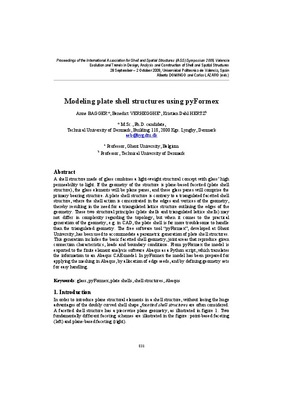JavaScript is disabled for your browser. Some features of this site may not work without it.
Buscar en RiuNet
Listar
Mi cuenta
Estadísticas
Ayuda RiuNet
Admin. UPV
Modeling plate shell structures using pyFormex
Mostrar el registro sencillo del ítem
Ficheros en el ítem
| dc.contributor.author | BAGGER, Anne
|
|
| dc.contributor.author | VERHEGGHE, Benedict
|
|
| dc.contributor.author | HERTZ, Kristian Dahl
|
|
| dc.contributor.editor | Domingo Cabo, Alberto
|
es_ES |
| dc.contributor.editor | Lázaro Fernández, Carlos Manuel
|
es_ES |
| dc.date.accessioned | 2010-01-26T12:45:51Z | |
| dc.date.available | 2010-01-26T12:45:51Z | |
| dc.date.issued | 2010-01-26T12:45:51Z | |
| dc.identifier.isbn | 978-84-8363-461-5 | |
| dc.identifier.uri | http://hdl.handle.net/10251/6949 | |
| dc.description | p. 831-842 | en_EN |
| dc.description.abstract | A shell structure made of glass combines a light-weight structural concept with glass' high permeability to light. If the geometry of the structure is plane-based facetted (plate shell structure), the glass elements will be plane panes, and these glass panes will comprise the primary bearing structure. A plate shell structure is contrary to a triangulated facetted shell structure, where the shell action is concentrated in the edges and vertices of the geometry, thereby resulting in the need for a triangulated lattice structure outlining the edges of the geometry. These two structural principles (plate shells and triangulated lattice shells) may not differ in complexity regarding the topology, but when it comes to the practical generation of the geometry, e.g. in CAD, the plate shell is far more troublesome to handle than the triangulated geometry. The free software tool "pyFormex", developed at Ghent University, has been used to accommodate a parametric generation of plate shell structures. This generation includes the basic facetted shell geometry, joint areas that reproduce given connection characteristics, loads and boundary conditions. From pyFormex the model is exported to the finite element analysis software Abaqus as a Python script, which translates the information to an Abaqus CAE-model. In pyFormex the model has been prepared for applying the meshing in Abaqus, by allocation of edge seeds, and by defining geometry sets for easy handling. | en_EN |
| dc.language | Inglés | en_EN |
| dc.publisher | Editorial Universitat Politècnica de València | es_ES |
| dc.relation.ispartof | Symposium of the International Association for Shell and Spatial Structures (50th. 2009. Valencia). Evolution and Trends in Design, Analysis and Construction of Shell and Spatial Structures : Proceedings | en_EN |
| dc.rights | Reserva de todos los derechos | en_EN |
| dc.subject | Glass | en_EN |
| dc.subject | Pyformex | en_EN |
| dc.subject | Plate shells | en_EN |
| dc.subject | Shell structures | en_EN |
| dc.subject | Abaqus | en_EN |
| dc.title | Modeling plate shell structures using pyFormex | en_EN |
| dc.type | Comunicación en congreso | en_EN |
| dc.rights.accessRights | Abierto | es_ES |
| dc.description.bibliographicCitation | Bagger, A.; Verhegghe, B.; Hertz, KD. (2010). Modeling plate shell structures using pyFormex. Editorial Universitat Politècnica de València. http://hdl.handle.net/10251/6949 | es_ES |
| dc.relation.conferencename | Symposium of the International Association for Shell and Spatial Structures | es_ES |
| dc.relation.conferencedate | 2009 | es_ES |
| dc.relation.conferenceplace | Valencia | es_ES |






